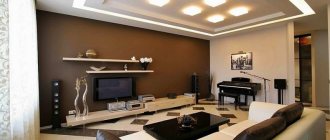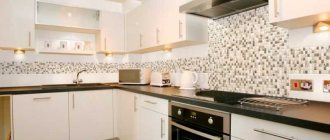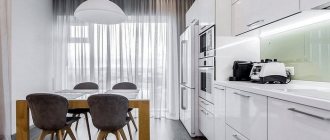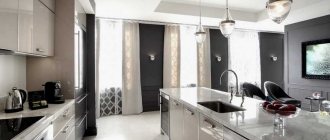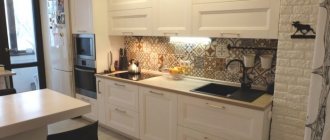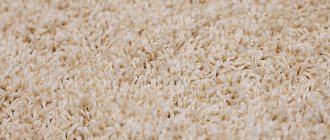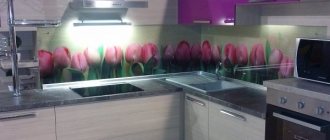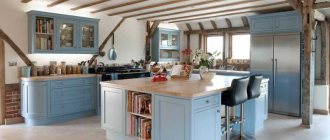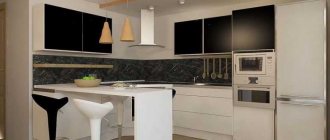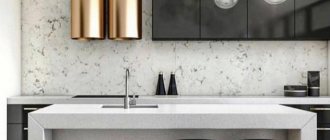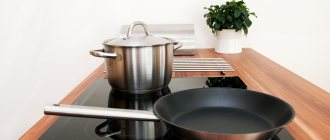An apron is the area of the wall that is located above the sink, stove, and work surface in the kitchen. Cupboards limit it from above, but in principle the options for arranging furniture are different. Water, fat, juice of fruits and vegetables, as well as all kinds of contaminants, as a rule, get on the surface when preparing culinary masterpieces and washing dishes.
"JuneJ/Shutterstock.com"
The purpose of aprons is to protect walls from all kinds of drops of water and grease when cooking and other activities in the kitchen are carried out. They are also used as a stylish element of room decor.
A large palette of colors and shades will be able to satisfy the wishes of every person regarding the color scheme of the apron for any kitchen.
Which material to choose?
Ceramic tile
Ceramic tiles can provide a considerable number of design options. Minimalism and classic style in the interior quietly use ceramics as a material. Absolutely any size of tiles is also an integral advantage of such aprons.
The overall picture will be unique and extraordinary. The most common types of tiles used are square and horizontal shapes. It looks very harmonious and aesthetically pleasing.
Mosaic
There are various categories of mosaics for kitchen backsplashes. Models can be classified by format, cost and color. Mosaic refers to small tiles of various colors. You can form a kind of picture or drawing from it; abstract sets of color spots are also quite popular.
A huge advantage of this particular material is the ease of cleaning of this type of apron. If the stains are fresh, they can be removed using a sponge using a regular soap solution.
When food splashes dry out and burnt fat remains, as well as other denser layers, there are methods for removing dirt specifically for a mosaic apron, for example, using abrasive cleaners and steel wool. For decorative coatings, such methods of removing grease and dirt are not applicable.
Thanks to the small elements of mosaic paintings, the splashes remaining on the surface after cooking are made invisible. When these are contrasting colors of the mosaic, then these options are most convenient to hide dirt.
The presence of minor dirt will not spoil the overall appearance of the kitchen, even when cleaning is not taking place. The combination of practical and aesthetic components in this material is the most harmonious.
A mosaic pattern will bring novelty to the overall atmosphere or complement the kitchen with a beautiful still life. In a spacious kitchen, you can create any image from this tile plan.
Plastic
A good alternative for tiles in the kitchen backsplash is plastic. The advantage of this apron is the excellent ratio of the cost of the product and its quality. The simple method of arrangement in the work area and the relative cheapness of this material captivate potential buyers.
"Jaroslav Moravcik/Shutterstock.com"
The color rendition of such material is accurate, shades transition from one to another perfectly, and there are no stripes.
The presence of direct contact with the wall can be attributed to the advantages of plastic; there are no gaps. Over time, color characteristics do not change. The heat resistance is increased, up to 220 degrees C. Resistance to abrasion, scratches and household chemicals is characteristic of plastic.
Optimal sizes of a kitchen apron
Often the height of the apron ranges from 45 to 60 centimeters. It is worth noting that the value directly depends on each specific case, because both the height of the owners and what the kitchen is filled with – the type of stove, as well as the furniture – play a role.
Many will agree that it will not be very convenient for a small housewife to use tall wall mounted modules, so it is worth reducing the space between the cabinets to 40-50 centimeters.
However, there are many parameters to consider. For example, a kitchen equipped with a gas stove must meet certain standards. The distance between the hob and the hood should exceed 75-80 centimeters. It is worth considering such a protrusion in the design.
Most often, the entire wall along the countertop is covered with finishing material. However, if desired, you can limit yourself to only small inserts in the most problematic areas, such as the hob and sink.
If there are no wall cabinets, then you can decorate the wall right up to the ceiling
It is important to understand that the apron should extend slightly behind all cabinets. In this case, the joint between the wall and the tabletop must be protected with a plinth, or even better, treated with silicone sealant. Why is this being done? Without this, water will gradually flow behind the floor cabinets and over time the back wall will swell and undergo deformation. Moreover, the entire wall is at risk of becoming infected with fungus.
Glass apron
The relevance of a glass apron has been proven today. Fashionability, practicality and ease of use - all this is about this model. There are transparent and colored options. Professionals apply a beautiful design to the glossy apron depending on the wishes of the clients.
In principle, there is no clear division for what style a given apron is used. High-tech, Provence - all these directions are suitable for such an apron. It is necessary to decide on the color of the design and choose it wisely.
The bright, glossy color of the apron will match well with strict, monochromatic and laconic colors. Considering a classic kitchen, it would be more appropriate to use pastel colors or transparent aprons.
Designing lighting for such aprons will make the overall look more advantageous. Thanks to it, the image will have saturation and depth. Even a banal kitchen will sparkle with new colors, shades of romance will appear in it. Dim lighting will help create an intimate atmosphere.
Color combination
As for the color of the apron, it is necessary to correctly combine the shades of kitchen furniture and fittings; the color of the walls is also taken into account. Some people prefer to play with contrasts. In this regard, opposite tones are used, while others, in turn, use only pastel colors.
Indeed, depending on what color is in the kitchen, such an emotional state will accompany a person in a given atmosphere. According to sociological surveys, it has been proven that colors and shades have some influence on the nervous system of people.
The tone of the tabletop will not play a major role here, but a harmonious combination with each decorative element is required.
Which apron to choose for a white kitchen?
Classics are always relevant, and this includes white sets. But here there is a need to complement the interior with a bright accessory in order to avoid facelessness. Premises that have a huge area are distinguished by the fact that white kitchens get lost in them.
On the advice of the designer, you can install an apron here, which will focus people's attention. To make an apron for a white kitchen, plastic in a wide range of colors, glass with various patterns, and tiles with patterns are used.
For black and white kitchen
Black and white colors are characterized by mystery, elegance, and intrigue. Black color has high energy. A white apron will be appropriate here; the space will not be overloaded. Also, using clean and bright colors will help liven up the atmosphere.
A red apron would be a suitable option. Orange, turquoise, green, yellow shades are also used. The color accent will be placed on the apron. Adding accessories of a similar color, chairs, and dishes looks beautiful. As another solution, you can consider glass with photo printing on the apron.
For beige
Ivory, cream, milk, and beige colors go well with contrasting aprons. Neutral beige is widespread among kitchen sets. It is necessary to think through all the subtleties and details.
An apron to match the wallpaper will harmoniously complement the interior and create a pleasant impression when cooking. There will be a connection of space. Minimal decor and patterns on the apron, when its shade matches the kitchen furniture, is the most common idea among famous designers.
Apron for green kitchen
White, beige, cream and coffee aprons can be classified as universal aprons. Brown color, in principle, is in harmony with green shades and all its tones. There will be a subtle contrast. Also a great solution would be a steel color in a metal apron. The closest styles here will be modern and high-tech.
For red kitchen
A glass apron for a red kitchen should be chosen with care. The color patterns on the backsplash with a red kitchen should be close to neutral, since the emphasis is already on the red color. But all customer wishes are taken into account. The main thing is that the kitchen does not look tacky and vulgar after adding an apron.
For orange
An orange kitchen is a very common option. Here you can combine bright facades with neutral tiles or false panels. It provides a gradation of gray, cream, beige, coffee, creamy shades.
What to do if your budget is limited?
If you find yourself in a situation where your budget is limited, or the renovation has already taken you beyond the planned limit, there are several solutions.
As an option, you can purchase a cheap set that has simple facades. All this should be complemented with neutral wallpaper and flooring. However, among other things, it is necessary to decorate the walls with more expensive tiles. Thus, we turn the apron into a kind of interior decoration.
Brick apron
There are several options for brick aprons: laying with artificial stone, brick, or fiberboard, on which a film with a brick image is applied. Despite the fact that preference is given to natural materials, artificial ones are also widely used.
The surface texture of such an apron is of great importance. In order to increase space and not absorb dirt and grease, it is recommended not to choose a coarse-grained texture. This is typical for Provence, country and loft styles. Also often used in Scandinavian variations.
Stationary or replaceable version
Tile, steel tiles, skins or steel finishing - all of these are extremely durable materials, as this is one of the conditions for use when lining the work area. But this option is not always considered the best: after all, replacing the casing is very difficult, and even a shame. And therefore, when choosing a finish, you need to solve this issue.
- Stationary materials include all durable and practical materials, the use of which guarantees a couple of decades of unchanged appearance. They can withstand heat, water and steam perfectly, are easy to clean and have many other advantages.
The photo shows a kitchen with ceramic granite tiles and countertops.
Conditionally replaceable, or rather, short-lived materials include polycarbonate or acrylic glass, plastic trim, chipboards, and so on. The material will have to be replaced not based on aesthetic requirements, but out of necessity, since both plastic and wood materials are not sufficiently resistant to temperature changes and heat.
- Replaceable - in this case, the apron consists of decorative and protective material. The first is any type of finishing - wallpaper, fabric, leather, vinyl film, cork, decoupage cards, etc. Replacing such material is not difficult. The protective material is a screen made of glass, or in extreme cases polycarbonate. Glass prevents damage to the delicate material, but it can be replaced at any time.
The photo shows vinyl film under glass.
The design of the work area is the most important part of the kitchen interior, since it must combine convenience and beauty. Modern materials and technologies make it possible to find a lot of solutions that satisfy all requirements.
With photo printing
Skinali is called a glass panel with photo printing; it is often used when decorating walls; façade inserts for kitchen furniture are also made using this technology. Skinali, which are used for the kitchen work area, are called glass aprons with photo printing for the kitchen. As a photo print, you can use any drawings that are dear to your heart.
Advantages and disadvantages of various materials
Before you start decorating your kitchen, you need to carefully study all possible options, because no one wants to end up with bad materials. To do this, it is worth studying each element in more detail, assessing its pros and cons.
Tile splashback
Perhaps this is the best option in terms of price, quality and durability. When finishing, glazed tiles are often used, and less often porcelain stoneware. It is lightweight and also quite suitable. Of the most popular formats, it is worth highlighting 10x10, 15x15, 20x30 and 20x40 cm. Also worth about.
Ceramics have a large number of designs that will satisfy even the most perverse taste and not very thick wallet. The surface of the tile can easily replicate the textures of stone, wood, concrete and even metal.
When choosing, you should pay special attention to the texture, because this is the working wall of the kitchen and the tiles will have to withstand an aggressive environment. Accordingly, it is better not to choose rough and embossed ones, but to give preference to smooth ones. This is due to the fact that keeping tiles with uneven surfaces clean will be much more difficult, and contamination will occur regularly.
One of the most common and effective kitchen design options is an apron decorated with hog-shaped tiles.
It is worth noting that in addition to various background tiles, which have a wide range of colors, manufacturers often include various ceramic panels and borders in their collections.
Let's consider the main parameters of this material:
Price
An apron trimmed with tiles will cost more than plastic, but it is also an order of magnitude cheaper than the same finish made of glass and acrylic stone. In addition to the cost of the material, it is worth considering the cost of the work itself, because it is necessary to level the surface before installation, purchase glue, grout, sealant, and also pay for the work of the master.
Installation
In a matter such as laying tiles, the best solution would be to entrust the work to a professional. The thing is that the kitchen work area is the center of attention and any shortcomings in the work will immediately catch your eye. It is almost impossible to lay tiles flawlessly without experience. It is also worth noting that ceramics are durable, but if you don’t like the style, then changing it will be problematic.
Preparation
Laying tiles requires extensive surface preparation. The entire wall will have to be leveled if necessary.
Durability
We remind you that ceramics is a durable material that will last 15 years or more even in the harshest conditions.
Moisture resistance
The tile has high moisture resistance, as it does not absorb moisture at all.
Care
In terms of maintenance, tiles are very versatile. To clean it, you can use various detergents, including abrasives. However, it is worth paying special attention to the grout, because ordinary light grout loses color and darkens over time - this does not look very neat. In order to avoid such problems, it is necessary to use epoxy grout, which retains its color.
Phototile apron
A very promising form of finishing that opens up wide possibilities. Of course, you can limit yourself to factory decors, which are present in the assortment of most large manufacturers, but you can also make photo panels to order.
Most of the characteristics of this type of finish are completely identical to ordinary tiles, but there are some significant disadvantages:
- Photo tile price. The cost is significantly higher than in regular collections
- If you buy inexpensive tiles that are made using the sublimation method, you can’t count on its durability. The tile itself will last a long time, but the design fades over time and also fades in the sun.
- Phototiles do not react well to aggressive household chemicals. When decorating an apron with photo tiles, it is worth considering that detergents with abrasive elements should not be used.
- Photo decors that are included in the factory-made catalog are much stronger and more durable than custom-made tiles.
Glass apron
A very unusual, but extremely beautiful and practical material for finishing. Moreover, glass can compete with ceramics in many properties, and it is much easier to maintain. Obvious advantages include heat and moisture resistance, which, in addition to extending the service life, also preserves the appearance.
Basically, tempered glass with a thickness of 6 or 8 mm with different designs is used to decorate the kitchen work area. It can be transparent, painted or tinted material. Photo printing is also possible.
Photo printing on glass tiles is applied in different ways.
Let's take a closer look at the main parameters of glass finishing:
Price
Perhaps glass finishing cannot be called budget. Moreover, glass panels with photo printing cost much more than tiles and mosaics, not to mention plastic.
In addition to the high cost of production, it is worth considering that you will have to pay additionally for the design to be tried on and adjusted (any image can be selected from the catalogue), photo proofs, installation, as well as holes for sockets - just some of the not obvious services for buyers.
One of the least expensive options is a clear glass screen. This is done in order to treat the wall under the surface of the glass at any whim. You can simply paint the wall or stick beautiful wallpaper.
Installation
This is perhaps one of the main advantages of glass finishing. Compared to its ceramic counterparts, this type of finish is characterized by a high installation speed with a complete absence of “dirty” work. The installation process can take up to two hours, but requires some skill and experience. However, there is a significant drawback: if the coating is damaged, you will not be able to get away with replacing a small fragment - you will have to replace the entire coating completely.
Preparation
For installation, special fasteners are used, for which there is no need to level the wall. The glass lags a few millimeters behind the surface, so it hides all the irregularities.
If an adhesive installation is used, the base must be perfectly clean, even and dry. This guarantees that the glass will hold up well.
Durability
Let's dispel a common myth among clients. This kind of decoration can decorate a kitchen for a very long time without losing its appearance. Moreover, figures can be provided to confirm this: some companies provide a product warranty for a period of 5 years.
However, do not forget that the guarantee is for a quality product made of tempered glass, which has UV printing with high-quality ink, and not for imitations made of plexiglass.
Moisture resistance
Of course, moisture resistance can be rated as an A, because glass does not allow water to pass through. Accordingly, the wall is safe and is not afraid of fungus.
Care
There is definitely a certain disadvantage in the glass coating - all traces that are not so clearly visible on ceramics are clearly visible on it. However, because the surface is smooth, the surface can be easily washed. Also, maintenance is simplified against the backdrop of a ceramic finish, because there is no need to clean numerous seams. In order to maintain order, you just need to periodically wipe the surface with a sponge and soapy water, and also sometimes use a glass care product.
Plastic apron
Plastic is an excellent choice for economy class kitchens or temporary renovations. This is especially true if you are going to do the repairs yourself. The apron is made from plastic panels, which come in a wide range.
There are two finishing methods: The first consists of a furniture panel made of MDF, chipboard, fiberboard, which is lined with decorative HPL plastic. This plastic can be plain or made to match any other material.
The second is to use a PVC wall panel. Such screens are very flexible and can be easily attached to the wall using glue or an aluminum profile. Perhaps, from the point of view of practicality, this method is inferior to furniture panels, because the apron loses color faster, and it is also impossible to install it near a gas hob. This is due to the fact that it has poor resistance to high temperatures. Such decisions are fraught with large deformations.
Main parameters:
Price
This is the most budget option of the selection, because a panel three meters long can be bought for about 1.5-3 thousand rubles.
Installation
The most important advantage of this choice is the simplest installation that even a beginner can handle. The thing is that plastic is very easy to handle. Unlike glass or ceramics, it is much easier to make holes for sockets and roof rails during installation. If the panel needs to be replaced, then the old ones are simply dismantled - this does not cause any difficulties.
Preparation
This often depends on the type, but most wall elements do not require leveling. The simplicity is due to the fact that everything is attached to the sheathing of slats using nails or self-tapping screws.
Durability
Undoubtedly, an element with such a huge number of advantages will have some disadvantages. Durability is one of them - from the general list it is the least durable material. Compared to other materials, plastic quickly deteriorates and must be replaced every 3-5 years. However, the advantages here include ease of replacement.
Moisture resistance
This indicator is also an order of magnitude worse than that of competitive materials, but even here, if you choose a high-quality material (MDF will be better than chipboard) and cover all joints with plinths, there should be no problems.
Care
Considering that the surface of the plastic is smooth and does not include any irregularities, it is worth noting that maintenance is very simple. It is enough just to periodically wipe the panels with a damp microfiber cloth or use a soft sponge. However, you should make sure that water does not flood the edges, because this can cause the base to swell.
Mosaic kitchen apron
First of all, it is worth noting that a mosaic backsplash in contrasting colors will transform your kitchen design from simple and dull to bright and dynamic. The fact is that it is very difficult to make a choice, because there are many varieties of mosaics. It can be glass, stone, ceramic or metal. The material can be nicknamed “chameleon”, because it changes its appearance depending on the lighting and time of day, respectively.
Let's consider the main evaluation criteria:
Price
In monetary terms, mosaic is difficult to compare with ceramics and porcelain stoneware. The fact is that it is more expensive. And in addition to the high cost of the material itself, it is necessary to take into account the cost of installation work: the work of the master, materials, as well as special glue and grout. If the budget is limited, then it is better to take mosaic tiles. The effect is not quite the same, but it saves money and makes installation easier.
Installation
Here, too, some difficulties arise, because many elements have a huge number of seams. Grouting them is a very labor-intensive process that requires great skill and accuracy. In addition, the work itself is very long.
Preparation
Everything here is twofold. On the one hand, the mosaic as such does not require leveling the walls, because it can be laid even on specially deformed surfaces, such as a radius wall, etc. However, in the kitchen you should carefully prepare the surface. If this is not done, the tiles can still be laid, but any unevenness will immediately catch your eye and completely ruin the whole effect, because the apron is the key, central element of the kitchen.
Durability
You don't have to worry about service life at all. The material is very high quality and durable. European manufacturers predict a normal service life of 20-25 years.
Moisture resistance
Mosaic, like any tile, does not allow moisture to pass through, so with proper finishing, as well as installing a plinth at the junction of the mosaic and the countertop, there should be no problems.
Care
Everything is the same as with ceramic tiles with only one exception - a large number of seams. The grout loses color over time.
Acrylic stone apron
Often, when choosing an artificial stone, buyers decide to make it into a countertop in addition to the apron. An excellent solution, because such an apron fits perfectly into a classic interior.
Price
This is the most expensive selection option. It’s not surprising, because not everyone can work with artificial stone. In addition, it is worth considering the leveling of the surface and sealing of joints.
Installation
As mentioned above, installation will require the help of a professional - a beginner will not be able to cope. However, there is a plus - the installation completely eliminates dirt.
Preparation
The panel is very thin and must fit tightly to the wall. Accordingly, before installation, you need to thoroughly prepare the base, completely get rid of unevenness and voids.
Durability
Here it is worth understanding that the material is very dependent on the treatment. By handling this apron competently and carefully, you can preserve it for many years. However, if you regularly touch the surface with various household items, such as pots and pans, the surface will begin to scratch and deteriorate. This problem can be easily solved with sanding and polishing, but it will be much easier to be more tidy in the kitchen.
Moisture resistance
The material, like its natural counterpart, does not allow water to pass through and is completely moisture resistant.
Care
In terms of care, the material is very good. Its surface completely eliminates the presence of cracks and pores, where dirt often collects, so the wall is easy to keep clean. For prevention, it is necessary to periodically wipe the apron with clean and soapy water. It is worth noting that even the most severe stains can be easily wiped off without the additional use of special products.
In conclusion, it is worth noting that the kitchen is yours and it is not always worth resorting to ready-made projects. Perhaps your ideas will be what your apartment was missing and the kitchen will turn into its main room.
With the image of flowers
The use of daisies, calla lilies, irises, roses, bluebells and orchids is a fairly common idea for designing a kitchen backsplash with flowers. Depending on the interior, the flower is considered. It is necessary to correctly combine shades for bright accents.
From stone
The cost of a product made of natural stone differs significantly from the price of an apron made of agglomerate stone, although the models of aprons may be similar. The production process and manufacturing have a number of features.
If the agglomerate is quartz, then it is easier to process. Granite and marble are similar in appearance to agglomerate. The affordability of prices cannot please buyers. The structure of the agglomerate is monolithic, there are no cracks or pores.
The advantages include high strength and long service life. The variety of agglomerates is explained by the presence of various dyes and pigments. Their richness and variety are impressive.
